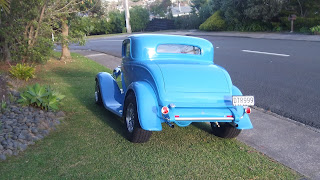You have to do this because bare fiberglass doesn't provide a good enough finish for paint to go straight over the top.
When new fibreglass comes out of a mould it has a gel coat finish, this is basically a fibreglass resin based paint that has a smooth glossy finish (you may remember me showing you this in an earlier blog Body - Goes into the mould) this glossy finish can be lightly sanded, primed and painted.
But........when you start griding into that gel coat finish as I have had to do, to make all my joins for the roof chop, you end up going down into the fibreglass itself and you start exposing the fibreglass fibres themselves and when sanded they make all these furry little ends that are porous. Here is a close up pic (double click on it). All the white spots are those fibreglass thread ends. There are also some air bubbles.
To overcome this I have ground all the joins slightly below the finished gel coat level (the finished surface) and will add a filler to bring it back up to the finished level and at the same time cover the fibreglass ends and air bubbles while providing a nice finish for the primer and paint. This is also often referred to as bogging!
I will be using this Epiglass HT450 filler powder. Thanks Mum and Dad, this is where my birthday money went :-)
This is amazing stuff, it is actually tiny little sphere's in fact they are sometimes referred to as "micro balloons" and they are very, very light. You pick up a scoop of these and it feels like you have nothing in the scoop and whats more they behave like a fluid, they pour like water and when you put them in a container you can swish it around just like a liquid.
Now obviously we can't just spread these straight on the car, they'd fall off and blow away. So we need a few other tools and ingredients.
The other beautiful thing about this filler is it mixes with the same resin I have been using with the fibreglass which means it bonds nicely to the layer of fibreglass it is being applied to......so that is the other main ingredient....resin.....oh and of course the hardener for the resin.
The other things in the picture below are the tools I will use......
- 2 litre icecream container for mixing the resin and adding the filler powder
- Resin and hardener
- 2 flexible metal spreaders for applying the filler
- A filler board used for carrying the filler on and to load up the metal spreader
- 2 different grades of sandpaper
- 2 different sanding longboards
Now that I have everything ready it was a case of mixing the resin and adding the filler powder.
I found that 5 drops of hardener per tablespoon of resin worked best and gave me enough time to get the filler onto the car before it set. This is more hardener than I used compared to when I was fibreglassing and that was largely attributed to the very cold weather we are having at the moment. The area I use for working on the car outside is on the cold side of the house with no sun and the temp hasn't been much above 8 degrees C (or about 45 degrees F for you Kevin). By adding more hardener though it helps speed up the reaction time and help the filler to set properly.
I used 5 tablespoon of resin with 7 tablespoons of filler powder to get a nice soft icing like filler. At this consistency it was easy to spread and it stayed on the car which is a good thing of course. Here you can see what I mean by it being like icing. Mmmmm so good you could eat it!
Now I have to say I was particularly disappointed with my ability at this point. The finish I got was nowhere near as good as what I had envisaged in my head.....so haven't taken too many pics. That said I am not worried as the finish is in the sanding, not in the filling. So long as you put plenty on you can always sand it back to the desired level and shape.
After some of the filler hardened I had a wee try with the longboards and tried to sand a bit. Here's what it came up like without too much effort. Don't look at the edges they will still need to be sanded, and ignore the wee pockets and bubbles, that's just because I have sanded deeply enough yet, but you can see how nice and smooth the filler has come up in the centre of the picture. Quite pleased really so I can't wait to get stuck into sanding on the next fine weekend we have.
Meantime though, its back inside so the filler can go nice and hard over the next few days.
Damn that resin smells good. I can even smell it upstairs in the house as I write this blog. I think I could get quite addicted.




































